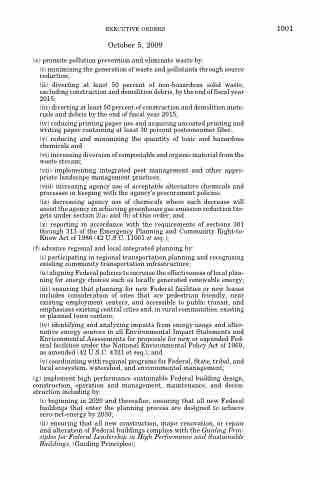Page 1011 - Demo
P. 1011
EXECUTIVE ORDERS 1001
October 5, 2009
(e) promote pollution prevention and eliminate waste by:
(i) minimizing the generation of waste and pollutants through source reduction;
(ii) diverting at least 50 percent of non-hazardous solid waste, excluding construction and demolition debris, by the end of fiscal year 2015;
(iii) diverting at least 50 percent of construction and demolition mate- rials and debris by the end of fiscal year 2015;
(iv) reducing printing paper use and acquiring uncoated printing and writing paper containing at least 30 percent postconsumer fiber;
(v) reducing and minimizing the quantity of toxic and hazardous chemicals and
(vi) increasing diversion of compostable and organic material from the waste stream;
(vii) implementing integrated pest management and other appro- priate landscape management practices;
(viii) increasing agency use of acceptable alternative chemicals and processes in keeping with the agency’s procurement policies;
(ix) decreasing agency use of chemicals where such decrease will assist the agency in achieving greenhouse gas emission reduction tar- gets under section 2(a) and (b) of this order; and
(x) reporting in accordance with the requirements of sections 301 through 313 of the Emergency Planning and Community Right-to- Know Act of 1986 (42 U.S.C. 11001 et seq.);
(f) advance regional and local integrated planning by:
(i) participating in regional transportation planning and recognizing existing community transportation infrastructure;
(ii) aligning Federal policies to increase the effectiveness of local plan- ning for energy choices such as locally generated renewable energy;
(iii) ensuring that planning for new Federal facilities or new leases includes consideration of sites that are pedestrian friendly, near existing employment centers, and accessible to public transit, and emphasizes existing central cities and, in rural communities, existing or planned town centers;
(iv) identifying and analyzing impacts from energy usage and alter- native energy sources in all Environmental Impact Statements and Environmental Assessments for proposals for new or expanded Fed- eral facilities under the National Environmental Policy Act of 1969, as amended (42 U.S.C. 4321 et seq.); and
(v) coordinating with regional programs for Federal, State, tribal, and local ecosystem, watershed, and environmental management;
(g) implement high performance sustainable Federal building design, construction, operation and management, maintenance, and decon- struction including by:
(i) beginning in 2020 and thereafter, ensuring that all new Federal buildings that enter the planning process are designed to achieve zero-net-energy by 2030;
(ii) ensuring that all new construction, major renovation, or repair and alteration of Federal buildings complies with the Guiding Prin- ciples for Federal Leadership in High Performance and Sustainable Buildings, (Guiding Principles);


